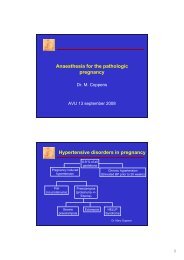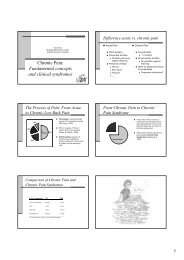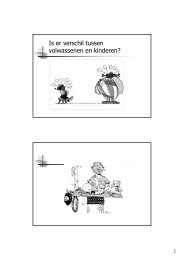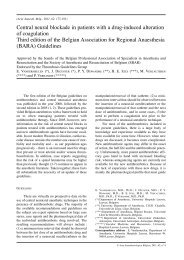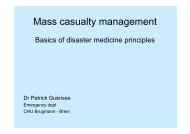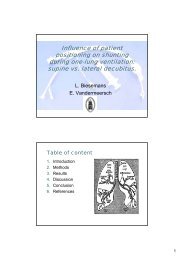Combined spinal epidural analgesia for labor and delivery
Combined spinal epidural analgesia for labor and delivery
Combined spinal epidural analgesia for labor and delivery
Create successful ePaper yourself
Turn your PDF publications into a flip-book with our unique Google optimized e-Paper software.
112 M. VAN DE VELDE<br />
<strong>analgesia</strong>. No differences in the incidence of nausea<br />
have between reported when comparing the two<br />
techniques, except in the retrospective trial by MIRO<br />
et al. who reported more nausea <strong>and</strong> vomiting in<br />
patients treated with <strong>epidural</strong> <strong>analgesia</strong> (98). We<br />
must remember that nausea is a part of the birth<br />
process especially during induced labour.<br />
Hypotension<br />
As with any neuraxial technique, hypotension<br />
can occur following labour <strong>analgesia</strong>. Both CSE <strong>and</strong><br />
conventional <strong>epidural</strong> <strong>analgesia</strong> have been associated<br />
with usually mild hypotension, which is easily<br />
treated (110). Both ROFAEL et al. <strong>and</strong> VAN DE VELDE<br />
et al. reported a high incidence of hypotension following<br />
CSE using a combination of local anesthetics<br />
<strong>and</strong> opioids (139, 162). Hypotension following<br />
the <strong>spinal</strong> injection is transient <strong>and</strong> occurs within the<br />
first 30 minutes following initiation of <strong>analgesia</strong><br />
(99, 149, 167). In that respect, it is important to<br />
avoid the supine position. We always keep our<br />
patients in the completely left lateral decubitus position<br />
to avoid any effect of aortacaval compression.<br />
Hypotension occurs due to sympathetic blockade,<br />
alleviation of pain <strong>and</strong> perhaps because incorrect<br />
baseline values are used as reference (13).<br />
Indeed, if the blood pressure that immediately precedes<br />
the block is considered as the baseline value,<br />
the diagnosis of hypotension may be made inappropriately.<br />
Pain <strong>and</strong> discom<strong>for</strong>t induce hypertension<br />
<strong>and</strong> cloud the issue. There<strong>for</strong>e, various authors recommend<br />
the use of the prenatal blood pressure as<br />
the baseline value.<br />
Although opioids do not produce sympatholysis,<br />
hypotension is observed with pure intrathecal<br />
opioid <strong>analgesia</strong> (26, 91, 102, 138). When local<br />
anaesthetics are combined, hypotension seems to be<br />
more pronounced, but is usually easily treated<br />
(102). Intrathecal clonidine, however, is often<br />
associated with severe hypotension <strong>and</strong> this author<br />
can not recommend it’s routine use, based on his<br />
personal experience. Hypotension can be severe<br />
<strong>and</strong> is often protracted, requiring prolonged supportive<br />
vasopressor therapy (27, 125).<br />
Respiratory depression<br />
Respiratory depression is a recognized complication<br />
of intrathecal opioids during <strong>labor</strong>, probably<br />
as a result of rostral spread. Several case reports<br />
have demonstrated that lipid soluble opioids may<br />
induce this potentially life threatening complication<br />
(10, 52, 63, 67, 73, 76, 90, 120, 124). In some,<br />
but not all cases, respiratory arrest can occur in relatively<br />
short stature women who received parenteral<br />
or <strong>epidural</strong> opioids prior to the <strong>spinal</strong> injection.<br />
Fortunately, respiratory depression typically occurs<br />
within the first 30 minutes <strong>and</strong> is easily reversed<br />
using naloxone. However, chest compressions <strong>and</strong><br />
resuscitation may be required (124). FERROUZ et al.<br />
per<strong>for</strong>med a retrospective chart analysis <strong>and</strong> reported<br />
1 respiratory arrest in over 5000 CSE per<strong>for</strong>med<br />
with 10 µg <strong>spinal</strong> sufentanil (52). As this complication<br />
is rare, most authors advocate vigilance <strong>and</strong><br />
advise to use lower doses of intrathecal opioids than<br />
those initially used on empirical grounds (5).<br />
Other complications related to excessive<br />
rostral spread of opioids <strong>and</strong> local anaesthetics have<br />
been described <strong>and</strong> include : aphonia, aphagia,<br />
dysphagia, altered levels of consciousness, high<br />
sensory block, transient swallowing difficulties,<br />
etc... (32, 41, 53, 65, 83, 145). Sudden hypoglyce -<br />
mia has also been described (40, 78).<br />
Central nervous system infections<br />
Some authorities claim that the risk of central<br />
nervous system infections is increased secondary to<br />
the breach of the dura (16). However, Camann <strong>and</strong><br />
Birnbach both agree that, at the moment, there is no<br />
scientific evidence indicating that CSE <strong>analgesia</strong> is<br />
associated with more infectious problems than<br />
<strong>epidural</strong> <strong>analgesia</strong> (13, 20). Indeed, several case<br />
reports of meningitis or <strong>epidural</strong> abscess have been<br />
reported following CSE anesthesia in obstetric<br />
patients (7, 15, 25, 66, 128, 167), but also after<br />
simple <strong>spinal</strong> anesthesia <strong>and</strong> conventional <strong>epidural</strong><br />
techniques (11, 45, 103, 136). Despite these<br />
occasional case reports, CNS infections remain<br />
extremely rare, irrespective of the neuraxial technique<br />
used. Six publications evaluate the risk of<br />
infections following neuraxial anesthesia in obstetric<br />
patients (5, 39, 68, 119, 123, 146). In over<br />
900.000 patients, only 2 cases of <strong>epidural</strong> abscess<br />
<strong>and</strong> 3 cases of meningitis were reported. Most<br />
authors, however, agree that strict aseptic techniques<br />
are of vital importance to prevent serious infections.<br />
Neurologic complications<br />
As with any regional technique, the potential<br />
<strong>for</strong> nerve damage is present. Several case reports in<br />
pregnant women of damage to the conus medullaris<br />
have been reported when using CSE (137).<br />
Especially with CSE, it is imperative to per<strong>for</strong>m the<br />
block as low as possible, as far as the conus<br />
medullaris might extend below the L2 vertebral<br />
© Acta Anæsthesiologica Belgica, 2009, 60, n° 2



